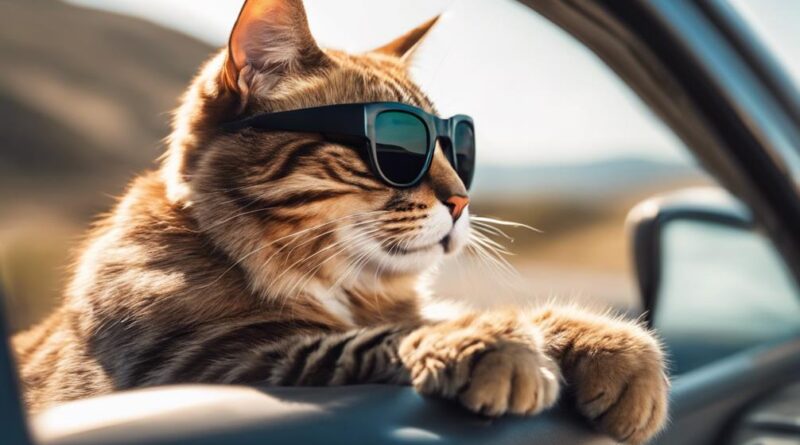Overcoming Motion Sickness for Cats on the Go
Imagine your feline friend navigating the bumps of a turbulent road trip like a sailor in stormy seas. Motion sickness in cats can be a challenging ordeal, but fret not, there are ways to ease their discomfort and make travels more enjoyable for both you and your cat companion.
By understanding the causes of motion sickness and implementing practical strategies, you can pave the way for smoother journeys ahead. So, how can you ensure your cat's next adventure is a pleasant one?
Understanding Motion Sickness in Cats
If your cat experiences motion sickness, it may exhibit symptoms such as excessive drooling, restlessness, and vomiting when traveling in a moving vehicle. To tackle this issue effectively, understanding the available treatment options and preventative measures is crucial.
When it comes to treatment options for motion sickness in cats, consulting your veterinarian is essential. They may recommend medications such as dimenhydrinate or meclizine to help alleviate your cat's symptoms during travel. These medications can help reduce nausea and vomiting, making the journey more comfortable for your feline friend. Additionally, your vet may suggest natural remedies like ginger or calming pheromone sprays to help relax your cat during trips.
In terms of preventative measures, there are several strategies you can implement to reduce the likelihood of your cat experiencing motion sickness. Gradual exposure to car rides can help desensitize your cat to the motion, making them more accustomed to traveling over time. Ensuring proper ventilation in the vehicle and keeping the interior at a comfortable temperature can also aid in preventing motion sickness. Moreover, feeding your cat a light meal a few hours before travel and providing a familiar blanket or toy can help reduce stress and anxiety, contributing to a smoother ride for your furry companion.
Symptoms of Motion Sickness in Cats
Understanding the symptoms of motion sickness in cats is crucial for identifying and addressing your feline's discomfort during travel. Behavioral cues and physical signs can help you recognize when your cat is experiencing motion sickness.
Behavioral cues may include excessive meowing, restlessness, pacing, or attempts to hide. Your cat might become agitated, exhibit signs of anxiety, or show reluctance to enter a vehicle. Additionally, if your cat starts drooling, yawning excessively, or licking their lips frequently, these could also be signs of motion sickness.
Physical signs of motion sickness in cats can manifest as vomiting, diarrhea, lethargy, or excessive grooming. Some cats may also pant, tremble, or have dilated pupils when feeling unwell during travel. These symptoms can be distressing for your furry friend and shouldn't be ignored.
To help manage motion sickness in cats, there are treatment options and prevention methods available. Before traveling, consider acclimating your cat to short car rides, using calming pheromone sprays, or consulting with your veterinarian about potential medications. By being attentive to your cat's behavioral cues and physical signs, you can take proactive steps to alleviate their discomfort and make traveling a more pleasant experience for both you and your feline companion.
Preparing Your Cat for Travel
Prepare your cat for travel by creating a familiar and comfortable environment in their carrier. Start by introducing your cat to the carrier gradually using training techniques. Place the carrier in a common area in your home with the door open and add comfort items like a cozy blanket or familiar toys inside. Encourage your cat to explore the carrier at their own pace, offering treats and positive reinforcement to associate the carrier with positive experiences.
When your cat begins showing interest in the carrier, start feeding them their meals near or inside the carrier to further build a positive association. As your cat becomes more comfortable, close the carrier door for short periods while they're inside, gradually increasing the time to help them acclimate to being confined.
Additionally, consider using pheromone sprays or calming aids to reduce your cat's stress levels during travel. These products can help create a soothing environment and alleviate anxiety. Remember to consult with your veterinarian before using any calming aids to ensure they're safe for your cat.
Choosing the Right Travel Carrier
To ensure your cat's comfort and safety during travel, selecting the appropriate travel carrier is crucial. When choosing a travel carrier for your feline friend, consider the following:
- Carrier features
- Opt for a carrier that's sturdy and well-ventilated to provide a safe and secure environment for your cat.
- Choose a carrier with secure latches or zippers to prevent any escape during transit.
- Look for a carrier that's easy to clean in case of any accidents during the journey.
- Ensure the carrier has a comfortable handle or shoulder strap for easy transport.
- Comfort considerations
- Select a carrier that's spacious enough for your cat to stand, turn around, and lie down comfortably.
- Line the carrier with a familiar blanket or bedding to provide a sense of security and comfort for your cat.
- Consider a carrier with a removable top or side entry for easy loading and unloading of your cat.
- Place a few familiar toys or treats inside the carrier to help keep your cat relaxed during the journey.
Strategies for Calming Anxious Cats
Consider incorporating calming pheromones or gentle music to help soothe your anxious cat during travel. Comforting techniques like these can make a significant difference in your cat's stress levels. Additionally, behavioral training can help desensitize your cat to travel-related stressors over time.
Natural remedies such as herbal supplements or pheromone sprays can be effective in calming anxious cats. These options are often less invasive than medication and can help alleviate your cat's anxiety during travel. Providing a familiar blanket or toy in the carrier can also offer comfort and a sense of security to your cat.
If your cat's anxiety is severe, consult with your veterinarian about medication options. There are medications available that can help reduce anxiety levels in cats during travel. Your vet can recommend the most suitable medication based on your cat's specific needs and health condition.
Feeding and Hydration Tips for Travel
For optimal hydration during travel, ensure your cat has access to fresh water at all times. Here are some feeding and hydration tips to keep your furry friend comfortable on the go:
- Food Placement: Place your cat's food and water bowls securely in the carrier to prevent spills. Opt for small, frequent meals rather than one large meal before travel to reduce the chances of an upset stomach.
- Water Availability: Offer your cat water regularly, especially during longer journeys. Use a spill-proof water dispenser or a shallow dish attached to the carrier door to ensure easy access without the risk of spills.
- Hydrating Treats: Consider bringing along some hydrating treats like wet food or ice cubes for your cat to nibble on during the trip. These treats can help keep your cat hydrated and provide a distraction during travel.
- Regular Breaks: If traveling by car, make regular stops to offer your cat water and a chance to use the litter box. This will help your cat stay hydrated and comfortable throughout the journey.
Minimizing Motion Sickness Triggers

Minimize your cat's motion sickness triggers by providing proper ventilation in the carrier during travel. Adequate airflow can help reduce feelings of nausea and discomfort. Additionally, ensure that the carrier is secure and stable to prevent excessive jostling during the journey.
Natural remedies can also be beneficial in minimizing motion sickness in cats. Consider using products like catnip or chamomile, known for their calming effects on felines. These natural remedies can help soothe your cat's nerves and alleviate symptoms of motion sickness.
Incorporating behavioral training techniques can help desensitize your cat to the stressors of travel, reducing the likelihood of motion sickness. Start by acclimating your cat to the carrier in a positive way, associating it with treats and comfort. Gradually increase the time spent in the carrier to help your cat feel more at ease during travel.
Seeking Veterinary Advice for Severe Cases
When facing severe cases of motion sickness in your cat, consulting with a veterinarian is crucial for proper diagnosis and treatment. Motion sickness can be distressing for your feline friend, and seeking professional guidance can make a significant difference in managing this condition effectively. Here's how veterinary advice can help you address severe cases of motion sickness:
- Accurate Diagnosis: A veterinarian can conduct a thorough examination to rule out any underlying health issues that may be contributing to your cat's motion sickness. This step is essential to determine the best course of action.
- Medication Options: Veterinarians can prescribe medications to help alleviate your cat's motion sickness symptoms. These medications may include anti-nausea drugs or sedatives to make travel more comfortable for your pet.
- Behavior Modification: Your veterinarian can provide guidance on behavior modification techniques to help desensitize your cat to travel and reduce anxiety associated with motion sickness. This may involve gradual exposure to car rides or using calming pheromones.
- Follow-up Care: Regular follow-up appointments with your veterinarian will allow for adjustments in treatment plans if needed. Monitoring your cat's progress and making necessary changes are crucial for effectively managing severe motion sickness.
Frequently Asked Questions
Can Motion Sickness in Cats Be Hereditary?
Motion sickness in cats can be influenced by genetic factors. While hereditary traits may predispose some cats to motion sickness, environmental triggers such as car rides or flights can exacerbate the symptoms.
If your cat experiences motion sickness, it's essential to consult with a veterinarian to determine the best course of action to alleviate their discomfort and make traveling a more pleasant experience for them.
Are Some Cat Breeds More Prone to Motion Sickness Than Others?
Some cat breeds may be more prone to motion sickness than others due to physiological differences. Prevention strategies can include acclimating your cat to travel slowly, using calming aids, and maintaining consistent travel habits.
Training techniques like desensitization can help reduce anxiety during travel. By identifying breed differences and implementing proactive measures, you can help your cat overcome motion sickness and make travel more comfortable for them.
Can Motion Sickness in Cats Be a Sign of an Underlying Health Issue?
Motion sickness in cats can indeed be a sign of an underlying health issue. Consider factors like dietary changes, stress levels, and environmental influences. Keep an eye on your cat's well-being and consult a vet if motion sickness persists.
Preventative measures, such as creating a calming environment during travel, can help alleviate symptoms and ensure your feline friend's overall health and comfort.
How Long Does It Typically Take for a Cat to Get Used to Traveling in a Car?
When getting your cat used to car travel, it varies how long it takes. Training techniques like gradual exposure help. Start with short rides, increasing time slowly. Positive reinforcement, calming aids can ease anxiety.
Cats may take days to weeks to adjust, depending on their temperament. Be patient and persistent, offering comfort and rewards. Each cat is different, so adjust the training according to your kitty's pace.
Are There Any Natural Remedies That Can Help Alleviate Motion Sickness in Cats?
If your cat struggles with motion sickness, you might consider trying some natural remedies. Herbal remedies and acupressure can help alleviate symptoms.
Additionally, behavior modification and exercise techniques can sometimes make a difference. Remember to consult with your veterinarian before trying any new treatments to ensure they're safe and appropriate for your feline friend.
Conclusion
Now that you have the tools and strategies to help your cat overcome motion sickness while on the go, you can make traveling a more enjoyable experience for both you and your furry friend.
By understanding the symptoms, preparing properly, and taking steps to minimize triggers, you can help your cat feel more comfortable and secure during travel.
Remember to consult with your veterinarian if your cat experiences severe motion sickness symptoms.
Safe travels!
